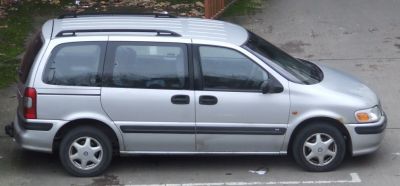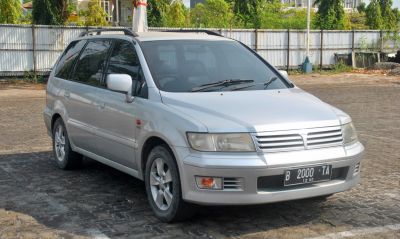 1998 Mitsubishi Space Wagon III Dimensions, Size & Specs
1998 Mitsubishi Space Wagon III Dimensions, Size & SpecsMeasurements of the 1998 Mitsubishi Space Wagon III, engineered for optimal performance and comfort
| Dimensions | |
|---|---|
| Length: | 4600 mm181.1 in15.1 ft |
| Width: | 1775 mm69.9 in5.8 ft |
| Height: | 1650-1690 mm65.0-66.5 in5.4-5.5 ft |
| Trunk Capacity: | 240 liter8.5 cu ft |
| Trunk Capacity (Max): | 240-1930 liter8.5-68.2 cu ft |
| Weight Specifications | |
| Curb Weight: | 1475-1720 kg3252-3792 lbs |
| Maximal permitted Weight: | 2120-2260 kg4674-4982 lbs |
| Tire Specifications | |
| Rims Size: |
|
| Tire Size: |
|
The Mitsubishi Space Wagon III, produced from 1998 to 2004, is a versatile minivan designed to offer spacious and practical transport for families and groups. Measuring 4600 mm (181.1 inches) in length and 1775 mm (69.9 inches) in width, this generation strikes a balance between a roomy interior and manageable exterior dimensions ideal for urban and suburban driving. The height ranges between 1650 mm (65.0 inches) and 1690 mm (66.5 inches), providing ample headroom and a comfortable seating position for passengers. The curb weight varies between 1475 kg (3,251 lbs) and 1720 kg (3,792 lbs), depending on the configuration and equipment, while the maximum weight capacity ranges from 2120 kg (4,675 lbs) to 2260 kg (4,982 lbs), allowing it to carry substantial loads safely.
Practicality is a key attribute of the Space Wagon III, showcased by its luggage capacity of 240 liters (8.47 cubic feet) with all rear seats occupied. When the rear seats are folded down, the space expands dramatically, offering between 240 and 1930 liters (8.47 to 68.1 cubic feet) of cargo volume to accommodate larger items or increased baggage. The vehicle runs on 15-inch steel rims fitted with 205/65 R15 tires, providing a balance of ride comfort and handling stability. Overall, the Mitsubishi Space Wagon III (1998-2004) remains a solid choice in the minivan segment for those seeking a reliable vehicle with generous interior space and practical features.
Discover the standout features that make the 1998 Mitsubishi Space Wagon III a leader in its class
Have a question? Please check our knowledgebase first.
The Mitsubishi Space Wagon III, produced from 1998 to 2004, measures 4600 mm (181.1 inches) in length, 1775 mm (69.9 inches) in width, and its height varies between 1650 mm (65.0 inches) and 1690 mm (66.5 inches), depending on the specific model variation. These dimensions place the Space Wagon III squarely within the mid-sized minivan class, offering a balanced footprint suitable for both urban and suburban driving environments.
The curb weight of the Mitsubishi Space Wagon III ranges from 1475 kg (3,251 lbs) to 1720 kg (3,792 lbs), depending on the configuration and optional equipment. Its maximum permissible weight (gross vehicle weight rating) spans from 2120 kg (4,674 lbs) to 2260 kg (4,980 lbs). This weight range indicates a robust build capable of comfortably carrying multiple passengers and cargo while maintaining stability and performance.
When all rear seats are in their upright position, the Mitsubishi Space Wagon III offers a modest luggage capacity of 240 liters (8.5 cubic feet), suitable for everyday errands or small trips. However, folding down the rear seats dramatically increases cargo space, allowing a capacity ranging from 240 liters to an impressive 1930 liters (68.2 cubic feet). This flexibility caters well to families or those requiring versatile transport solutions.
The Mitsubishi Space Wagon III is equipped with 15-inch rims paired with tires sized 205/65 R15. This tire setup offers a good balance between comfort, road grip, and ride quality, optimized for the typical driving conditions and weight of this mid-sized minivan.
Standard garage dimensions typically range around 2.4 meters (8 feet) wide and 5.5 meters (18 feet) deep. Given the Space Wagon III's width of 1775 mm (69.9 inches or approximately 1.78 meters) and length of 4600 mm (181.1 inches or approximately 4.6 meters), it will comfortably fit within a standard garage with sufficient clearance for door opening and maneuvering, although the relatively taller height up to 1690 mm (66.5 inches) should be checked against any low garage ceilings.
Compared to the Space Wagon II generation, the Space Wagon III generally grew in several dimensions to improve interior space and comfort. The length increased to 4600 mm (181.1 inches), which is generally longer than the previous generation, allowing for better legroom and cargo capacity. Width and height also saw slight increases, contributing to a more spacious cabin environment. This evolution was designed to meet the growing demand for family-oriented minivans with versatile space utilization.
In comparison with other mid-size minivans from the late 1990s and early 2000s, such as the Toyota Previa or Honda Odyssey, the Mitsubishi Space Wagon III holds its own with a length of 4600 mm (181.1 inches), a width of 1775 mm (69.9 inches), and a height ranging from 1650 to 1690 mm (65.0 to 66.5 inches). These specifications provide a competitive balance of interior space and maneuverability. While its luggage capacity with seats folded (up to 1930 liters or 68.2 cubic feet) is impressive and comparable to rivals, space optimization and ride comfort were central to its design. Additionally, certain rivals may offer larger engine options or more modern amenities, but the Space Wagon III remains reliable and practical for families.
The Mitsubishi Space Wagon III generally accommodates 7 passengers across three rows of seating, making it a true minivan suitable for larger families or groups. The interior layout offers flexibility with foldable rear seats to accommodate variable passenger and cargo needs. This adaptable design enables users to prioritize passenger space or maximize luggage capacity when needed, reflecting the multi-purpose nature typical of minivans in this segment.
Yes, the height of the Mitsubishi Space Wagon III ranges from 1650 mm (65.0 inches) to 1690 mm (66.5 inches). These variations typically arise from differences in trim levels, roof configurations, or included options such as roof rails or sunroofs. Certain models may have enhanced ground clearance or body kits that slightly increase the vehicle’s overall height. Such variations ensure the vehicle meets different consumer preferences and functional requirements.
The Space Wagon III is fitted with 15-inch rims and 205/65 R15 tires, a combination that balances ride comfort, handling stability, and fuel efficiency. The relatively tall sidewall height (aspect ratio of 65) helps absorb road imperfections well, contributing to a smoother ride for occupants. The tire width of 205 mm (8.1 inches) offers sufficient road grip, which is essential for a minivan that carries multiple passengers and cargo. This setup is well-suited to daily driving, long-distance cruises, and urban environments where ride quality is paramount.
Discover similar sized cars.

| Production: | 1997-1999 |
|---|---|
| Model Year: | 1996 |
| Length: | 4670 mm183.9 in |
| Width: | 1830 mm72.0 in |
| Height: | 1711 mm67.4 in |

| Production: | 1997-2003 |
|---|---|
| Model Year: | 1997 |
| Length: | 4585-4650 mm180.5-183.1 in |
| Width: | 1780 mm70.1 in |
| Height: | 1650-1690 mm65.0-66.5 in |
